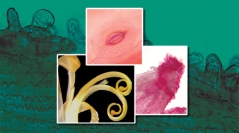

 Adansonia
42 (12) - Pages 227-239
Adansonia
42 (12) - Pages 227-239Osmophores are engaged in scent production and differ from other secretory structures by their product, site, duration, and anatomical structure. Whereas osmophores have been well-documented in flowers of several families, they are barely mentioned in the Asteraceae. The aims of this study are to: 1) determine the occurrence of osmophores in corollas of 39 species of the tribe Onoserideae and the only species of Famatinantheae with histochemical methods; and 2) analyze the morphology and structure of osmophores in these groups. Histochemical and histological techniques revealed osmophores in the marginal and in the central corollas of Famatinanthus Ariza & S.E. Freire and Plazia Ruiz & Pav. at the apex and margin of the corolla lobes, and at the sinuses. Osmophores were confirmed following positive staining reactions for TIOFH and TIOFH3 (Neutral Red, Oil Red O, and Iodine-Potassium-Iodide); the samples reacted negatively for Benedict’s test for detecting reducing sugars. The osmophores found in this study are constituted uniquely by a papillose or non-papillose epidermis, or they extend into the mesophyll forming scent glands. In both cases, they are associated to stomata and starch grains. The corollas of the other species of Onoserideae did not react positively for osmophores.
Anatomy, Asteraceae, Compositae, histochemistry, osmophore, scent production, secretory structures